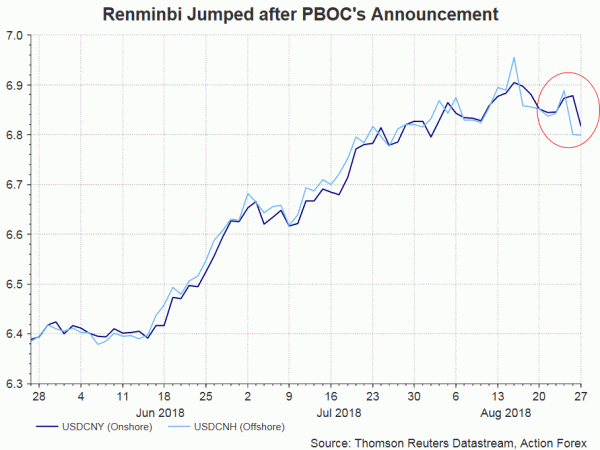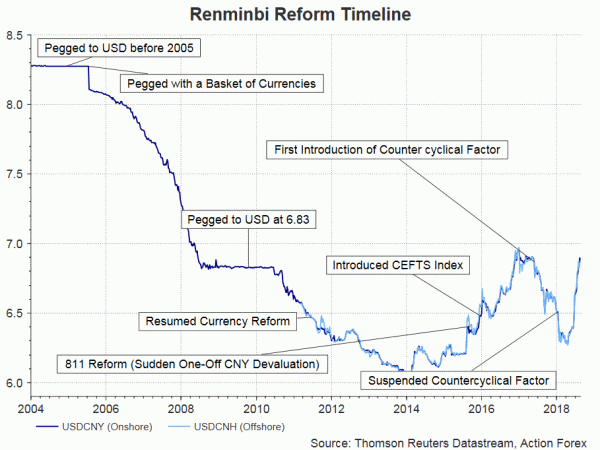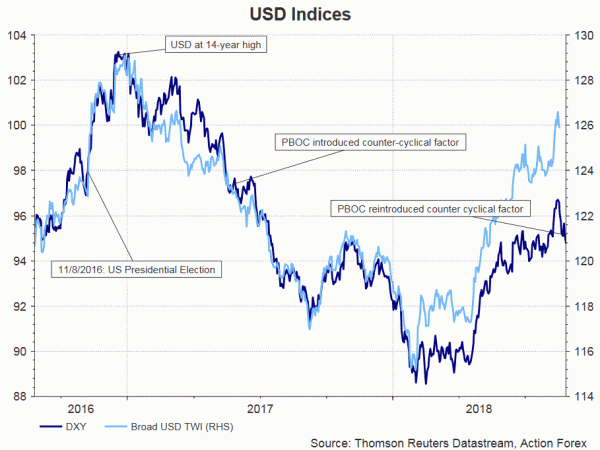China is on pins and needles as it sees renminbi (Chinese yuan) fall. The government dares not risk massive capital flight for uncertain benefit in exports by depreciating its currency. The apparent increases in FX reserve over the past months could hardly conceal concerns over renminbi weakness, which has been driven by rapid slowdown in China’s growth and exacerbated by the Trump-induced trade conflict which appears to be an endless game.
Last Friday, PBOC announced that the “counter-cyclical factor” has once again been used in exchange rate fixing, after abandoning it since the beginning of the year. Despite disguising the intervention as stabilization, the move evidenced that the government is really uncomfortable with further weakness in renminbi. The timing of the “re-introduction” is no coincidence. It is intentionally adopted in early- to mid- August, when US dollar is off from its peak and amidst strong criticism by US’ Trump over renminbi weakness.
What is “Counter-Cyclical Factor”?
It is one of tools the PBOC uses to maintain renminbi in stable levels. First announced on May 26, 2017, the government explained that it would help prevent renminbi from being excessively affected by external volatility. Yet, it revealed no details about how the countercyclical factor would be computed or its weight in the new fixing mechanism. The tool only ran for about half a year and was suspended on January 9, 2018. Its comeback indicates that the daily renminbi fixing mechanism now contains three components:
- Previous day’s USDCNY closing price
- Exchange rate movements of a basket of currencies
- Counter-cyclical factor
Timing for Using the Tool
China first introduced the counter-cyclical factor when the US dollar was falling and shortly after US-China trade negotiation. Recall that the greenback rallied shortly after Trump won the Presidential election in November 2016 before reaching a 14-year high in December. The reflation rally of the greenback was fully erased in mid-May 2017, following by further weakness thereafter. China has been responsive to US’ call for strong renminbi. Somehow forgotten, US and China did agreed at the Mar-a-Largo meeting in May last year to “advance US-China economic cooperation with a 100-day action plan under the framework of the US-China Comprehensive Economic Dialogue”. It was believed that US had urged China to allow its currency to rise, resulting in the announcement of the counter-cyclical factor weeks later.
Now, with USD in correction after reaching a 2018-high in the middle of this month and shortly after a US-China trade talk by low-level officials, China probably finds it appropriate to signal that it is defending the renminbi. Notwithstanding the rhetoric that the counter-cyclical factor is to stabilize the currency, the intervention is more on prevention the currency from weakening, rather than strengthening. Since the beginning of this month, USDCNY fixing has dropped -0.37%, compared with a -0.22% fall in USD index (DXY). During the period, onshore renminbi has gained slightly more than +0.1% against the greenback while the CEFT renminbi index has rising +0.39%. Obviously, the counter-cyclical factor is functioning to send renminbi higher.















